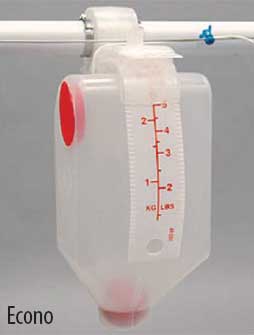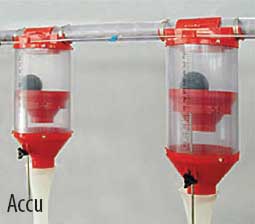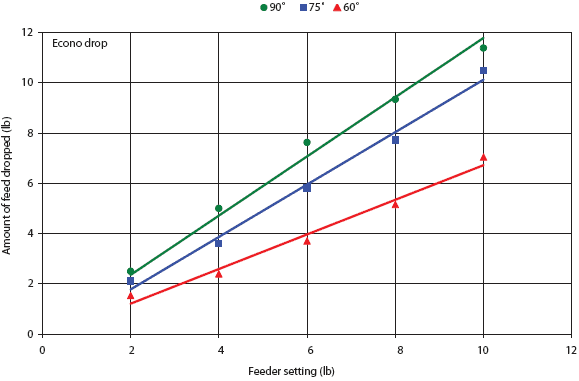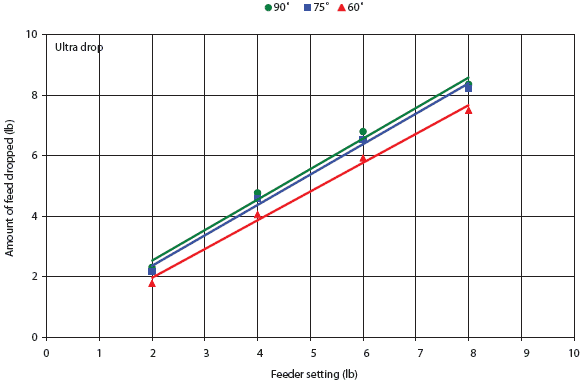Schneider JD, Tokach MD, Dritz SS, et al. Determining the accuracy of gestation feed drops.J Swine Health Prod. 2008;16(6):298-303
| Original research | Peer reviewed |
Cite as: Schneider JD, Tokach MD, Dritz SS, et al. Determining the accuracy of gestation feed drops.J Swine Health Prod. 2008;16(6):298-303.
Also available as a PDF.
SummaryObjective: To determine the accuracy of three different types of gestation feed drops. Materials and methods: Econo, Accu, and Ultra feed drops (Automated Production Systems, Assumption, Illinois) were attached to feed lines at three angles (90°, 75°, and 60°). Feed was collected and weighed at settings of 2, 4, 6, 8, and 10 lb (0.9, 1.8, 2.7, 3.6, and 4.65 kg) for the Econo and Accu feed drops and 2, 4, 6, and 8 lb for the Ultra feed drops. Results: There was a drop type × angle × feed level interaction (P < .01) for the feed settings versus the actual amount dropped. At 90°, the relationship between the feeder setting (x) and actual quantity of feed dropped was best described by the regression equation (1.156x + 0.244) for the Econo, (1.010x + 0.072) for the Accu, and (1.009x + 0.231) for the Ultra feed drops. At 75°, the regression equations were (1.014x – 0.139) for the Econo, (0.997x + 0.057) for the Accu, and (1.005x + 0.156) for the Ultra feed drops. At 60°, the regression equations were (0.689x – 0.076) for the Econo, (0.989x – 0.249) for the Accu, and (0.951x + 0.026) for the Ultra feed drops. Implications: The type of feed drop and its angle relative to the feed line influences the amount of feed dispensed at a feeder setting. The Accu and Ultra feed drops more accurately dispense the correct amount of feed than the Econo feed drops. | ResumenObjetivo: Determinar la precisión de tres tipos diferentes de caídas de alimento en gestación. Materiales y métodos: Se agregaron caídas de alimento Econo, Accu, y Ultra (Automated Production Systems, Assumption, Illinois) a las líneas de alimento en tres ángulos (90°, 75°, y 60°). El alimento se recogió y pesó en medidas de 2, 4, 6, 8, y 10 lb (0.9, 1.8, 2.7, 3.6, y 4.65 kg) para las caídas de alimento Econo y Accu y 2, 4, 6, y 8 lb para las caídas de alimento Ultra. Resultados: Hubo una interacción de tipo de caída × ángulo × nivel de alimento (P < .01) para las medidas de alimento contra la cantidad realmente descargada. A 90°, la relación entre la medida del alimentador (x) y la cantidad real de alimento descargado se describió mejor con la ecuación de regresión (1.156x + 0.244) para las caídas de alimento Econo, (1.010x + 0.072) para las Accu, y (1.009x + 0.231) para las Ultra. A 75°, las ecuaciones de regresión fueron (1.014x – 0.139) para las caídas de alimento Econo, (0.997x + 0.057) para las Accu, y (1.005x + 0.156) para las Ultra. A 60°, las ecuaciones de regresión fueron (0.689x – 0.076) para las caídas de alimento Econo, (0.989x – 0.249) para las Accu, y (0.951x + 0.026) para las Ultra. Implicaciones: El tipo de caída de alimento y su ángulo relativo a la línea de alimento influyen en la cantidad de alimento administrado. Las caídas de alimento Accu y Ultra administran con mayor precisión la cantidad correcta de alimento que las caídas de alimento Econo. | ResuméObjectif: Déterminer la précision de trois types différents de distributeurs automatisés d’aliment pour truie gestante. Matériels et méthodes: Les systèmes automatisés Econo, Accu, et Ultra (Automated Production Systems, Assumption, Illinois) ont été reliés à des lignes de distribution d’aliment à trois angles d’attache (90°, 75°, et 60°). De la moulée a été amassée et pesée à des réglages de 2, 4, 6, 8, et 10 lb (0.9, 1.8, 2.7, 3.6, et 4.65 kg) pour les systèmes automatisés de distribution Econo et Accu, et à des réglages de 2, 4, 6, et 8 lb pour le système automatisé Ultra. Résultats: Une interaction (P < .01) en fonction du type de système × angle × réglage a été notée pour le réglage versus la quantité exacte de nourriture distribuée. À un angle de 90°, la relation entre le réglage du système (x) et la quantité exacte de nourriture distribuée était le mieux décrite par l’équation de régression (1.156x + 0.244) pour le système Econo, (1.010x + 0.072) pour le système Accu, et (1.009x + 0.231) pour le système Ultra. À 75°, les équations de régression étaient (1.014x – 0.139) pour le système Econo, (0.997x + 0.057) pour le système Accu, et (1.005x + 0.156) pour le système Ultra. À 60°, les équations de régression étaient (0.698x – 0.067) pour le système Econo, (0.989x – 0.249) pour le système Accu, et (0.951x + 0.026) pour le système Ultra. Implications: Le type de système de distribution et son angle relatif par rapport à la ligne de distribution influencent la quantité de nourriture distribuée selon le réglage. Les systèmes Accu et Ultra distribuent plus précisément la quantité de nourriture que le système Econo. |
Keywords: swine, feed, feed drop, gestation
Search the AASV web site
for pages with similar keywords.
Received: June 6, 2007
Accepted: April 15, 2008
The use of individual gestation stalls or crates allows producers to control sow feed intake and the overall growth of the gilt or sow.1,2 Individual feed drops are used to provide a set amount of feed to each animal. These feed drops are made by several manufacturers and marketed in a variety of designs. However, information on the accuracy of individual feed drops has not been published. As a further complication concerning the question of accuracy, feed drops are installed and intended to be used perpendicular (90° angle) to the feed line. However, either beginning at installation or after years of use, many drops are at angles of < 90° to the feed line. The influence of the angle to the feed line on accuracy of feed drops is not known. If the angle influences accuracy, producers could utilize this information in equipment-purchasing decisions and management of existing feed drops. Thus, the objective of this experiment was to determine the accuracy of three different styles of individual drop feeders when they were fitted at angles of 90°, 75°, and 60° to the feed lines.
Materials and methods
This experiment was conducted at the Kansas State University Swine Research and Teaching Center. The experimental diet contained 63% corn and 33% soybean meal, with the remainder of the diet consisting of vitamins and minerals. The diet was formulated to 1.15% true ileal digestible lysine, 21% crude protein, and 3287 kcal of metabolizable energy per kg. Particle size was approximately 700 microns. All feed drops were purchased from Automated Production Systems (Assumption, Illinois; www.automatedproduction.com) and attached to a 5-cm feed line. The Ultra, Econo, and Accu feed drops were used in this experiment (Figure 1).
| Figure 1: Three commercial feed drops used in an
experiment to determine the accuracy of different styles of
individual drop feeders. Top to bottom: Econo, Accu, and Ultra drop
feeders (Automated Production Systems, Assumption, Illinois).
Photos courtesy of Automated Production Systems.
|
Feed drops were adjusted to the specific test angles by using a Johnson Magnetic Angle Locator (Johnson Level and Tool, Mequon, Wisconsin). Two feed samples were collected and weighed at each angle and feeder setting. The feeder settings were 2, 4, 6, 8, and 10 lb (0.9, 1.8, 2.7, 3.6, and 4.6 kg) for the Econo and Accu feed drops. Due to the smaller capacity feed reservoir of the Ultra feed drop, samples were collected at all settings except 10 lb. Samples were weighed on an Ohaus Champ II Bench Scale accurate to the nearest 0.01 kg (Ohaus Balance and Scale, Pine Brook, New Jersey).
Statistical analysis
A total of 15 feed drops were blocked on the basis of location on the feed line, with one feed drop of each type randomly allotted to a location within each block. There were a total of five blocks on the feed line, with each block consisting of three continuous openings spaced 0.31 m apart. Each block included one feed drop of each type (Econo, Accu, and Ultra) randomized for order within the block. Each feed drop was considered an experimental unit. As part of the experimental protocol, all feed drops were aligned to a specific test angle (90°, 75°, or 60°), with the drop set to a specific target feed-drop setting (eg, 2.0 lb). The feed drops were allowed to fill to their targeted amounts and the feed was emptied into a collection container. The drop was then filled again and the collection procedure was repeated. The feed drops were then set to the next targeted amount and the procedure repeated. Finally, the drop was aligned to the next specific test angle with the procedure repeated. This allowed the data to be analyzed as a split-split-plot design with the feed drop as the whole plot and angle and feeder setting as the subplots. The model included the random effect of block and fixed effects of feed-drop type, target feed level, and angle. The model included the main effect of drop type, angle setting, and target feed level as well as the interactions of type × angle × feed level and type × feed level. The difference between the targeted feed level and the actual feed collected as a measure of bias were used to determine the accuracy of each drop type at all angles and target feed settings. The assumption for normality of differences and residuals was evaluated using the Shapiro-Wilk and the Kolmogorov-Smirnov test with the UNIVARIATE procedure in SAS (SAS Institute Inc, Cary, North Carolina). There was no evidence (P > .05) to suggest that the differences or residuals were non-normally distributed. Analysis of variance was performed using the PROC MIXED procedure of SAS. Least squares means, protected by significant F-tests, were compared using least significant difference tests. Due to the three-way interaction between type, angle, and feed level for the differences, linear regression equations were developed for the mean values of each drop type and angle setting. The standard error of repeatability was calculated as the standard deviation of the difference between replicates. Finally the standard deviation of the predicted values was calculated as the standard deviation of the difference of feed dropped minus the actual feed-drop setting adjusted for the mean bias.
Results
The overall bias was relatively low (-0.09 lb, -0.04 kg) as was
the standard error of repeatability (0.17 lb, 0.08 kg). However,
the relatively large standard error of prediction
(0.95 lb, 0.43 kg) indicates that, for each setting, the actual
amount of feed dispensed varied. Further analysis indicated that
there was a feed drop type × angle × feed level interaction
(P < .01) observed for the amount of feed dropped versus
the feed-drop setting (Table 1). There also was a type × feed level
interaction for the difference in the amount of feed provided when
the feed drops were moved from a 90° to a 60° angle. The Econo feed
drop was most affected by angle to the feed line, and the
difference in the amount of feed dropped when the angle changed
from 90° to 60° was greater (P < .05) than that for the
Accu and Ultra feed drops. The difference between the setting and
the target weight was greater (P < .05) for the Econo
feed drop than for the Accu and Ultra feed drops at almost all
feeder settings. With the feed drop set at a 60° angle from the
feed line at most feeder settings, the weight difference between
the actual and the targeted amount of feed was greater for the Accu
feed drop than for the Ultra feed drop (P < .05).
However, with the feed drop set at the 90° and 75° angles, the Accu
feed drop was more accurate than the Ultra feed drop (P <
.05) at all but the lowest (2 lb) feeder settings.
Table 1: Effect of feed-drop type and angle from the feed line on the difference in actual weight of feed dropped (kg) and the feed-drop setting (bias), tested in three commercial drop feeders*
* Econo, Accu, and Ultra feed drops provided by Automated Production Systems, Assumption, Illinois (www.automatedproduction.com). † Type × angle × feed level interaction (ANOVA; P < .01). ‡ Type × feed level interaction (ANOVA; P < .01). ND = not done. Function of the Ultra feed drop was not measured at 4.6 kg due to its limited storage capacity. abc Values within a row with no common superscript are different (ANOVA; P < .05). |
|||||||||||||||||||||||||||||||||||||||||||||||||||||||||||||||||||||||||||||||||||||||||||||||||||||||||||||||||||||||||||||||||||||||
There was a type × angle × feed-level interaction (P < .01) observed for the slope and intercept of regression equations developed to predict the amount of feed dropped at each feeder setting. Regression analysis indicated the slope differed from 1 for the Econo feed drop at an angle of 90° (P < .01), 75° (P < .05), or 60° (P < .01; Figure 2). The intercept differed from 0 for the Econo feed drop at an angle of 90° (P < .01), 75° (P < .01), or 60° (P < .10).
| Figure 2: Example of the actual amount of feed dispensed
at each feed-drop setting (2, 4, 6, 8, and 10 lb) when the Econo
feed drop (Automated Production Systems, Assumption, Illinois) was
mounted at the recommended angle (90° to the feed line) and at 75°
and 60° angles. Regression equations for the specific angles, where
“x” represents the feed-drop setting and y represents
the actual amount of feed dispensed at that setting, are the
following: 90°, y = 1.156x + 0.244, r2 = 0.99; 75°, y =
1.014x – 0.139, r2 = 0.99; 60°, y = 0.689x –
0.076, r2 = 0.98.
|
The slope did not differ from 1 for the Accu feed drop at all three angles (P > .05; Figure 3). The intercept tended to differ from 0 for the Accu feed drop at an angle of 90° (P < .10) and 60° (P < .10).
| Figure 3: Example of the actual amount of feed dispensed
at each feed-drop setting (2, 4, 6, 8, and 10 lb) when the Accu
feed drop (Automated Production Systems, Assumption, Illinois) was
mounted at the recommended angle (90° to the feed line) and at 75°
and 60° angles. Regression equations for the specific angles, where
“x” represents the feed-drop setting and y represents
the actual amount of feed dispensed at that setting, are the
following: 90°, y = 1.010x + 0.072, r2 = 0.99; 75°, y =
0.997x + 0.057, r2 = 0.99; 60°, y = 0.989x – 0.249,
r2 = 0.99.
|
The slope did not differ from 1 for the Ultra feed drop at 90° and 75° (P > .05), but differed from 1 at an angle of 60° (P < .05; Figure 4). The intercept differed from 0 for the Ultra feed drop at angles of 90° (P < .01) and 75° (P < .01), but did not differ from 0 at 60° (P > .05).
| Figure 4: Example of the actual amount of feed dispensed
at each drop setting (2, 4, 6, and 8 lb when the Ultra feed drop
(Automated Production Systems, Assumption, Illinois) was mounted at
the recommended angle (90° to the feed line) and at 75° and 60°
angles. Regression equations for the specific angles, where
“x” represents the feed-drop setting and y represents
the actual amount of feed dispensed at that setting, are the
following: 90°, y = 1.009x + 0.231, r2 = 0.99; 75°, y =
1.005x + 0.156, r2 = 0.99; 60°, y = 0.951x + 0.026,
r2 = 0.99.
|
Discussion
Sows housed in gestation stalls are typically fed once or twice daily by volumetric feed drops. Accuracy of the feed drops is important to prevent overfeeding or underfeeding. If sows are overfed during gestation, they may accumulate > 21 mm backfat at farrowing, which is associated with lower feed intake during lactation.3-5 Conversely, if sows are underfed during gestation, they may not achieve the desired 17 mm of backfat, putting them potentially at risk of not rebreeding after farrowing.5 Sow feed costs typically account for approximately 12% of the producer’s total feed costs.6 Feeding and nutrition of the sow may greatly influence sow lifetime productivity, and this affects the operation’s profitability.6 Sow welfare may also be affected if proper amounts of feed are not provided. This report, to our knowledge, is the first to provide data concerning accuracy of gestation feed drops.
The three feed drops tested in this study are designed to be mounted at a 90° angle to the feed line. These data demonstrate that, when the three types of feed drops are mounted at a 90° angle, the Accu and Ultra feed drops are more accurate than the Econo feed drop. The difference in accuracy at the different angles tested is potentially related to the way that the different drops attach to the feed line. The Accu and Ultra feed drops are attached to the feed line along the entire top of the drop. Conversely, the Econo feed drop is attached only in the middle and at the back of the drop. The Econo and the Ultra feed drop are similar in shape and measuring system. Both feed drops are “box” shape and measure the amount of fill by use of a “ribbon” measuring system, where the feed enters the drop through a chute and fills until the feed level reaches an adjustable ribbon. However, the box, and ultimately the feed-delivery chute, are turned 90° for the Ultra compared with the Econo feed drop. Because of this, when the drop is rotated away from a perpendicular angle from the feed line, feed flow is affected to a greater extent with the Econo than with the Ultra feed drop. For the Accu feed drop, feed volume is determined by the height setting for the plate within the cylinder. The volume that can enter the cylinder does not change greatly as the angle to the feed line changes. One concern with this design is that if the plate doesn’t remain on a consistent plane with the feed settings on the cylinder, the drop may become more difficult to set. The volume entering the cylinder would not change if the plate was not flat; however, determining the exact setting would be more difficult. A simple solution to this problem would be for the manufacturer to print four equally spaced measuring labels on the sides of the cylinder.
The amount of feed collected in each drop appears to increase linearly as the feeder settings are increased, regardless of the angle setting (90°, 75°, or 60°). Thus, to adjust for the variability in the amount of feed that is accumulated, regression equations can be developed for each type of feed drop for the angle of the feed drop to the feed line. This requires either that all feed drops are set at the same angle to the feed line, or that a separate equation is developed for each angle. This highlights the importance of feed drops being maintained at the same angle relative to the feed line within a production facility.
Density of the diet, which was not evaluated in this study, also requires calibrating feed drops. Feed-drop settings are based on dropping a volume of feed that corresponds to the average weight of a corn-soybean meal diet. The accuracy of the feed drop may be affected when feeds of different densities are used, eg, pelleted feeds or feeds containing fibrous ingredients. Furthermore, particle size of the diet and the diameter of the feed line can also contribute to a feed drop’s accuracy.
The accuracy of feed drops may cause performance loss in gilts and sows because of over-consumption or under-consumption of nutrients during gestation. For example, a 250-kg sow has a maintenance requirement of approximately 2.0 kg of a standard gestation diet. If an Econo feed drop were set at 6 lb (2.7 kg) to provide feed to this sow for desired weight gain, it would supply the sow with 1.4 kg and 0.6 kg of feed above maintenance requirements when the feed drop is at angles of 90° and 75° to the feed line, respectively. If the feed drop were set at a 60° angle, the sow would receive 0.3 kg of feed less than the amount required for maintenance. If the feed drop remained on the same feed setting for the entire gestation period, the sow could lose weight (60° angle) or gain as much as 50 kg (90° angle). Conversely, if the Accu feed drop were set at 6 lb (2.7 kg) to feed the same sow, she would receive 0.8, 0.7, and 0.4 kg of feed above maintenance when the drop was set at angles of 90°, 75°, and 60°. The amount of weight gain over a gestation period would be within a range of 15 to 28 kg.
Implications:
- The type of gestation feed drop and its angle relative to the feed line influences the amount of feed dispensed at a feeder setting.
- It is important to maintain feed drops at the same angle relative to the feed line within a production facility.
- The Accu and Ultra feed drops are more accurate than the Econo feed drop.
- All gestation feed drops should be checked periodically to determine the amount of feed dropped at the setting.
- Veterinarians and consultants can develop regression equations for producers’ feed drops to improve the accuracy of targeted vs actual feed allowances.
References
1. Barnett JL, Hemsworth PH, Cronin GM, Jongman EC, Hutson GD. A review of the welfare issues for sows and piglets in relation to housing. Aust J Agric Res. 2001;52:1–28.
2. Trottier NL, Johnston LJ. Feeding gilts during development and sows during gestation and lactation. In: Lewis AJ, Southern LL, eds. Swine Nutrition. 2nd rev ed. Boca Raton, Florida: CRC Press; 2001:725–769.
3. Dourmad JY. Effect of feeding level in the gilt during pregnancy on voluntary feed intake during lactation and changes in body composition during gestation and lactation. Livest Anim Sci. 1991;27:309–319.
4. Revell DK, Williams IH, Mullan BP, Ranford JL, Smits RJ. Body composition at farrowing and nutrition during lactation affect the performance of primiparous sows: I. Voluntary feed intake, weight loss, and plasma metabolites. J Anim Sci. 1998;76:1729–1737.
5. Young MG, Tokach MD, Aherne FX, Main RG, Dritz SS, Goodband RD, Nelssen JL. Comparison of three methods of feeding sows in gestation and the subsequent effects on lactation performance. J Anim Sci. 2004;82:3058–3070.
6. Young M, Aherne F. Monitoring and maintaining sow condition. Adv Pork Prod. 2005;16:299–313.





